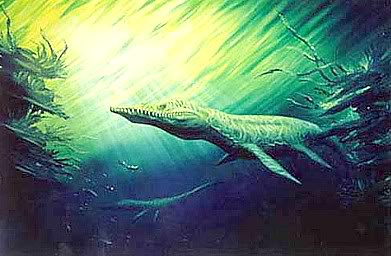Prehistoric Marine Reptiles
Most wild animals today have the ability to swim, and this was probably true for dinosaurs as well. Dinosaurs were probably swim to escape from other predators, to cross small rivers running away from fires... But dinosaurs did not live in water.
Their anatomical composition made dinosaurs suited for locomotion on land. However, during the age of dinosaurs, the waters were still busy with all kinds of life, including many types of marine reptiles.
While dinosaurs ruled the lands, pterosaurs dominated the skies, several groups of reptiles dominated the seas. These groups included: nothosaurus, plesiosaurs, pliosaurs, ichthyosaurs, and mosasaurs.
Prehistoric marine reptiles had similar body features to their land relatives such as dinosaurs. They had scaly skin, eyes, teeth, limbs and and tails. They did not have gills, and were not able to breathe underwater like a fish, instead they had lungs like the dinosaurs.
 Prehistoric
marine reptiles had body shapes that were smooth and sleek, this would
have allowed them to move with ease through the water.
Prehistoric
marine reptiles had body shapes that were smooth and sleek, this would
have allowed them to move with ease through the water.
Their limbs evolved into flippers, for rowing or paddling, rather than for walking and running.
Their teeth were adapted to catching slippery fish or squid, and crushing hard case shellfish.
It is believed that these reptiles were driven into the oceans by dinosaurs and other fierce predators.
It became difficult for these reptiles to find food and to avoid the danger on land. There was a wide variety of food in the seas such as fish, shellfish, star fish, crabs, squid, even jellyfish and sea bed worms.
The main predator already in the oceans were the sharks, which had been around for nearly 200 million years earlier, during the Devonian Period.